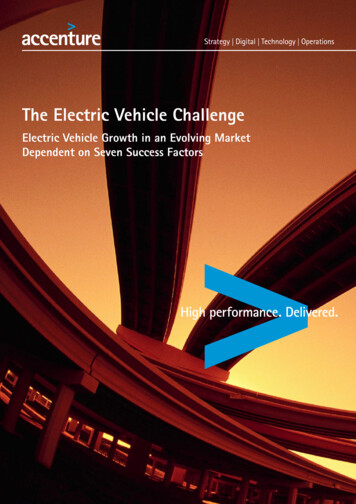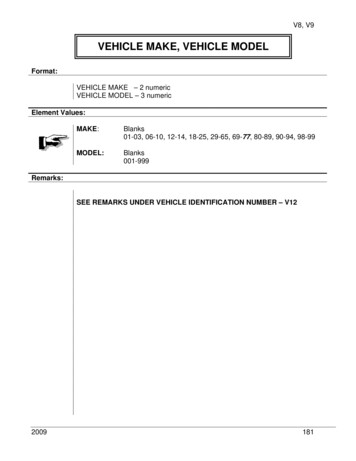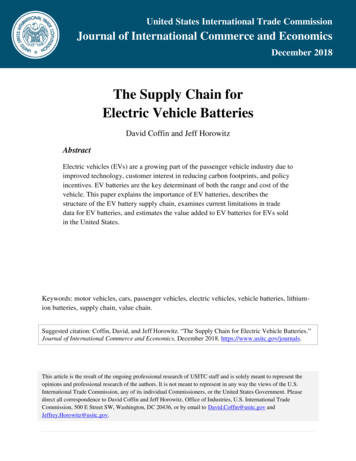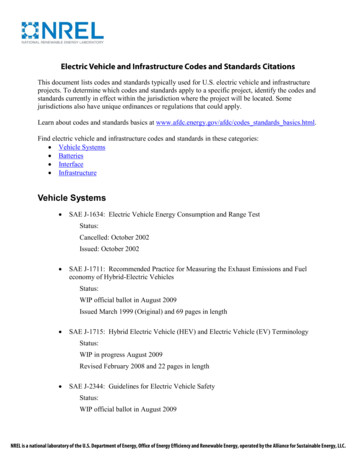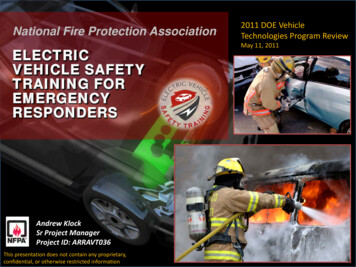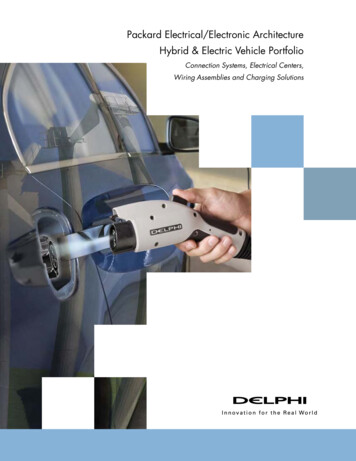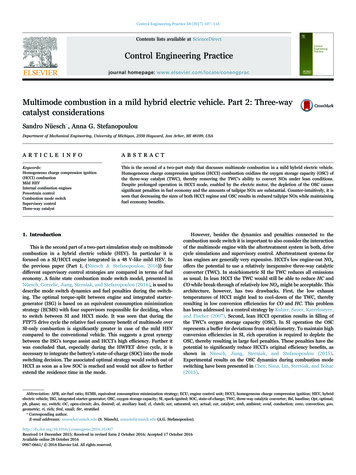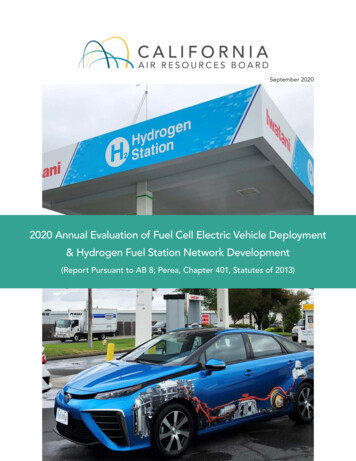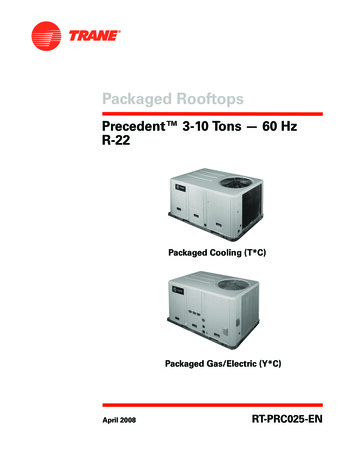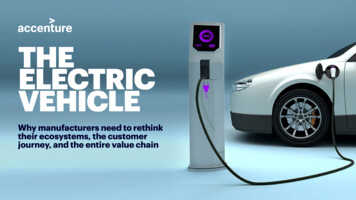
Transcription
THEELECTRICVEHICLEWhy manufacturers need to rethinktheir ecosystems, the customerjourney, and the entire value chain
Mobility’s next stop: Electric vehiclesThe mobility industry has been responding to a global demand for higher sustainability for many years. The electricvehicle (EV) is one answer. The acceleration toward EV production is shaking up the automotive industry in ways no onecould have predicted. How manufacturers respond could mark an industry revolution not seen in decades.Original equipment manufacturers (OEMs) face growing pressure to addressa dramatically shifting industry and customer landscape:SUSTAINABILITY NEEDS are growing and maturing, especially amongyoung people, and particularly where mobility is concerned.NEW CUSTOMERS—who are living in urban areas and are more likely touse multi-modal urban transportation—are inclined to use digitalchannels to stay updated on the latest technology developments.THE CIRCULAR ECONOMY is pushing the automotive industry tomake environmentally friendly vehicles along their whole lifecycle—fromgreen production using renewable energies to responsible batterydisposal and chemical recycling.Pushing the e-revolution along, EVs are becoming increasinglysophisticated. For example, Tesla Inc. pioneered the concept of sellingwirelessly updatable vehicles, demonstrating that it is possible to transferupdates and new features to the vehicle much in the same way consumersdownload new software to their smartphones. Today other traditionalautomotive manufacturers are following suit.1EVs are clearly emerging largely as a result of global demand for greenermobility solutions. And over the next decade, battery-powered electricvehicles (BEVs) will be more prominent and gain significant market share.How OEMs respond will steer the industry in new, unchartered directions,driven largely by new customers (and a new customer experience), anevolving value chain evolution and a new essential ecosystem.FAST EVOLVING TECHNOLOGIES are reshaping the passenger vehiclethrough Connectivity, Autonomous, Sharing and Electrification (CASE)trends.The Electric Vehicle 2
Electrification is at the center of the mobility revolutionWhile e-mobility is a huge game-changer, electrification is not the only factor shaking up the automotive industry.Together, CASE megatrends are revolutionizing the mobility status quo.Electrification is accelerating the mobility revolution, and is benefitingfrom connectivity, shared mobility and autonomous vehicle partnerships(see next page).DID YOU KNOW?Hyundai Motor GroupIn 2019, Hyundai launched the first rural carsharing service in Spain thatuses 100% electric technology. By using the ‘Carsharing Rural VIVe deHyundai’ mobile app—which was developed specifically for this service—users can manage their reservation, unlock the vehicle and locate thenearest charging station, thus highlighting an efficient solution for ruralmobility.2 By 2025, all new vehicles are expected to be connected, and by2030, 30% will likely be electric3 58% of autonomous, light-duty vehicle retrofits and models are builtover an electric powertrain4 45% of car-sharing providers in Europe already operate a 100%electric fleet5The Electric Vehicle 3
Megatrends shaping the mobility revolutionAUTONOMOUSSHARING Address customerconcerns providingthe possibility to tryEVs using sharingservices Facilitate fleetmanagementsharing, reducingmaintenance needsand enabling highervehicle availability Reduced emissionsencouragesmunicipalities topush electricsharing fleets Range extension thanks toefficient vehicle management but higher computing powerhas impacts on the battery Higher vehicle availability dueto autonomous management ofcharging and maintenanceactivities Vehicle development forelectrification & EV features (e.g.fewer moving parts) facilitatesautonomous technologyadoption Technology-focused adopterswant both autonomous andelectrification innovationsELECTRIFICATION Vehicle re-design for electrification facilitatesconnectivity technology adoption Remote control over EVs status and remotemanagement Grid connection with related chargingservicesCONNECTIVITYThe Electric Vehicle 4
The battery: At the heart of the revolutionEVs depend in large part on battery power, which changes several components of the traditional OEM playbook.A new energy tank that redefines the vehicle: COSTS: The battery represents a single component worth up to 35% of thevehicle’s total value PERFORMANCE: Affects mileage range, charging time and engine power EVOLUTION: No longer just a standalone vehicle but an active part of thegrid enabling effective energy management (vehicle-to-grid or vehicle-tohome solutions)New materials driving a new supply chain: New suppliers and battery manufacturers become essential partners for EVdevelopment New raw materials—lithium, cobalt, nickel and other materials sourced fromalternative countries, such as Democratic Republic of Congo and China,creating potential geopolitical and ethical issuesA new re-fuel concept driving a new customer experience: From refueling to re-charging From gas station to charging station or home charging From vehicle to integrated device, collaborating and exchanging energywith future smart home and citiesA component with a second life: Disposed batteries are becoming new energy storage packs enablingrenewable energy sources for peak management, opening to new services(such as battery pack rental solutions) or to be used as new batteries forlower performing vehiclesThe Electric Vehicle 5
Electrification at a glanceElectrification involves a lighter powertrain with a new energy tank (highvoltage batteries), and an increasing emphasis on software. These changesto the vehicle accelerate the need for a new e-customer journey.Specifically, EV drivers will have a very different charging experience thatcompletely upends the concept of refueling. For example, an EV takesmuch longer to charge than a simple three-minute fill-up at the traditionalgas pump.Companies are already responding to this development. Volkswagen, forexample, offers a new platform specifically for EVs—the Modular ElectricDrive matrix.DID YOU KNOW?Driven by stringent CO2 emissions targets, European governments andautomotive players in 2019 committed to 60 billion in investments toproduce EVs and batteries—3.5 times higher than in China.12Fiat ChryslerFiat Chrysler Automobiles is making buying an EV easier by offering at-homecharging stations on popular consumer websites and including installationservices for any branded EV charger.6COVID-19 EFFECTSThe COVID-19 global pandemic, which introduced social distancingand other major lifestyle changes, redefined mobility. A globallockdown affected every aspect of the automotive sector—from partssuppliers to dealers.But the push toward vehicle electrification continues unabated—COVID-19 will not stop the revolution. In fact, the number of EVs on theroad is expected to reach almost 10 million this year, as sales growdespite the pandemic.7 And amid the crisis, EV sales could reach arecord share of the overall vehicle market this year.8While converging forces affected its speed differently by region, thee-revolution nevertheless will drive to more sustainable mobility.The Electric Vehicle 6
The law of threesThree motivating forces arepushing OEMs toward the EVmarketE-mobility is leading to a radicalchange of three key automotiveelementsThree geographies are l eadingthe e-mobility t rendGovernment regulations and incentivesMore stringent CO2 emission regulations aredovetailing with incentives and subsidies thatsupport EV investment, promotion and sales.Adopting a new e-value chainThe standard value chain needs to evolve todeal with a new EV, not only from theengineering and manufacturing side, but alsofrom the user perspective. It should include newsuppliers and meet new customer needs andexpectations.ChinaThe Chinese government is driving mobilityelectrification with significant investments ininfrastructure, supply chain development andpurchase incentives, making China the biggestEV market in the world.Infrastructure and technology developmentWidespread availability of charging stationsand technological enhancements (such ashigher battery capacity) will all but guaranteevehicle usability and increase customeracceptance.Creating a new customer experience(for new customers)A new customer experience is evolving basedon charging time and needs. Customers aremore attentive to the impact on theenvironment and the use of renewable energyand resources.EuropeEurope is increasing efforts toward moresustainable mobility, multiplying investmentsin both EV production (led by German vehiclemanufacturers) and battery supply chaindevelopment (European Battery Alliance) andpenalizing OEMs exceeding emissions targets.Customer e-readinessConsumer awareness of the direct impact theirchoices and behavior have on the environmentare increasingly advancing e-mobility.Discovering a new ecosystemNew players are gaining prominence as theydisrupt the long-held automotive status quo. Tobe successful in this market, these newcompetitors are investing in developing a robustEV ecosystem and charging infrastructure.USAIn the U.S., many states are investing in EVsand adopting stronger regulations, targetingmore sustainable mobility and emissionsreduction.The Electric Vehicle 7
Manufacturers face three additional hurdlesTraditional OEMs are facing new challenges related not only to a newproduct, but also to emerging customer expectations and skepticism towardEVs (see next page). They must address three main issues to reach the massmarket:1. Vehicle profitabilityHigh investments—which are required for EV development and production—significantly impact OEMs’ profitability. This is at a time when sales volumesare still limited and purchasing prices must be contained to make EVsaffordable and appealing to customers.2. Vehicle usabilityCustomers’ concerns about EVs’ range and limited charging options remaindespite major improvements in technology and infrastructure.3. Environmental sustainabilityEVs’ total sustainability is a significant challenge, forcing OEMs and allplayers to focus on vehicles’ entire lifecycle—not only tank-to-wheel butwell-to-wheel emission reduction.A new essential ecosystem isemergingThe electric revolution creates a new, evolving ecosystem thatincludes utilities, charging infrastructure developers, new mobilityservice providers and battery manufacturers, to name a few importantcategories. OEMs will have to work with new players and orchestratethe ecosystem to develop a consistent offering of vehicles, servicesand charging experience.For example, Daimler has created a “live replacement parts store“ forthe fleet of third-generation EVs. The battery storage plant is availableto the energy market to supply primary balancing power. Its modulardesign enables the system to continuously and automatically stabilizethe power grid with balancing power. This solution is an example ofhow batteries could be turned into an opportunity for OEMs whilesupporting and integrating with utilities and grid operators.13The Electric Vehicle 8
Main challenges affecting traditional OEM value chainManage EV technology evolution(e.g. dedicated vs. mixed platform,solid state vs. lithium battery)Revisit the Software architectureto manage new electric andelectronic components (e.g.battery management systems)EngineeringManage Customer Anxiety(e.g. battery range and reliability,charging infrastructure) and newcustomer journey touchpointsAddress lower margins on EVsales despite increase in priceand meet new cyclingMonitor and integrate InternalCombustion Engine (ICE)and Battery Electric Vehicle(BEV) suppliers. Managenew component transportationand stocking constraintsManage ICE and BEV assemblylines with opposite volumes trendsand update workforce skillsSupply chainPurchasingAfter salesManufacturingDeal with new players comingfrom outside automotive whilemaintaining traditional onesMobilityservicesManage batterypack life cyclefrom 2nd life (e.g.battery storage) toraw material reuse.ECOSYSTEMConnectedvehicleservicesRespond to the decreaseof revenues due tomaintenance changes.Shift from ownership towardusership (e.g. sharing andsubscription models)Leverage EV data to developnew services to customers(e.g. software update, chargingexperience, proactivecustomer care) and tomonetize new opportunitiesCollaboration with newecosystem players(e.g. Charging Point Operator(CPO), Mobility Service Provider(MSP), Utilities, )The Electric Vehicle 9
Value Chain Actions: A roadmap for a traditional OEMTraditional OEMs need to evolve, following different steps along the entire value chain to stay competitive and effectivelyride the wave of the electrification revolution. In particular, OEMs will need to focus on a number of key areas to staycompetitive and manage in the era of the electric engine—from engineering to manufacturing to recycling.1. EngineeringDefine a clear technology evolution strategy (and develop a dedicatedEV platform). Take advantage of engineering services to redesignproducts and seize new technologies to simulate component behaviorsuch as long-term battery performance.5. MarketingCreate awareness and desire for EVsproviding clear information around productand services and developing new salesoptions. Redesign the customer journey toenhance EV-specific touchpoints.6. Sales and Mobility ServicesReview sales strategies redesigning the retail network,integrating direct and indirect channels and usingmobility platforms to facilitate EV usability. Introduceinnovative mobility services to offer customers valuablealternatives to buy (such as car and/or fleet sharing,subscription models).8. AftersalesRe-evaluate OEM capabilities to effectivelymanage new EV and dedicatedcomponents (such as batteries) whileoffering new e-servi
The electric revolution creates a new, evolving ecosystem that includes utilities, charging infrastructure developers, new mobility service providers and battery manufacturers, to name a few important categories. OEMs will have to work with new players and orchestrate the ecosystem to develop a consistent offering of vehicles, services
